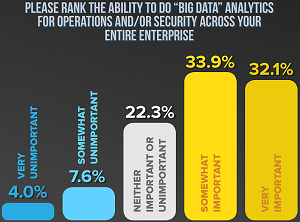News
Mainframe Survey Reveals 4 Key Big Data Trends for 2017
- By David Ramel
- January 18, 2017
Syncsort Inc. today published the results from its annual "State of the Mainframe" survey, which revealed four key trends for mainframe-based Big Data analytics in 2017.
The company, which describes itself as a "Big iron to Big Data" leader, garnered data from more than 220 respondents to come up with the new report. Those respondents include executives, architects, system programmers, application analysts, database administrators, operations managers and security professionals.
Syncsort said the survey highlights the increasing importance of mainframe computing in enterprise datacenters, especially those that use modern data architectures for Big Data analytics projects.
"Companies still rely on the mainframe to process their most important transactional data, but we're seeing an increased focus on integrating this data within Big Data analytics platforms to provide a complete enterprise-wide view of data for intelligence on business-critical operations, security breaches and compliance audits," said exec David Hodgson in a statement.
"The mainframe is no longer the isolated black box it once was, and more organizations are realizing the immense benefits of performing analysis off the mainframe for real-time results, while investing in solutions that simplify data movement between platforms to bring together key enterprise-wide business information," Hodgson continued.
 [Click on image for larger view.]
The Importance of Big Data (source: Syncsort)
[Click on image for larger view.]
The Importance of Big Data (source: Syncsort)
Here are the four trends for 2017 Syncsort identified from combing through the survey data:
- Organizations will move mainframe application and log data to next-generation Big Data analytics platforms. 60 percent of respondents indicated that they plan to move mainframe data off-platform for analytics. A growing number of large organizations are now looking to leverage modern data architectures like Hadoop, Spark and Splunk to analyze mainframe application and log data at scale and at the speed of business.
- Security and compliance mandates will be key drivers for technology evaluations and mainframe data analytics. 66 percent of respondents ranked the ability to do Big Data analytics for operations and/or security across the entire enterprise as important. Mainframes host some of the most sensitive business and operations information for large enterprises. For this reason, mainframe application and log data are also emerging as critical data sources for security and compliance initiatives, which were ranked as the top initiatives for IT executives and IT organizations.
- Technologies that enhance and monitor data movement between platforms will rise in importance. 62 percent of respondents don't feel they are able to effectively track data in motion. Organizations are looking for tools to monitor data movement across a variety of platforms and let them know what data is being moved, by whom, when and where.
- Big Data analytics for operational intelligence, security and compliance will continue to grow and emerge as a critical project in many organizations. 48.6 percent of respondents indicate it is desirable for their organization to have access to log, SMF or other data on the mainframe for correlation with distributed data in Big Data and analytics platforms (Splunk, Hadoop and so on). This reflects an emerging trend in how z/OS operational data can be used on advanced analytics platforms to gain valuable business insights, driven by the limitations of the static nature of the display capabilities of existing mainframe tools.
"The survey also confirmed mainframe's continuing role as the predominant platform for performing large-scale transaction processing on mission-critical applications," the company said in a statement. "Given mainframe's critical part in their IT strategy, many organizations (over a third in the study) are concerned over their ability to staff mainframe operations adequately as traditional mainframe experts retire."
About the Author
David Ramel is an editor and writer at Converge 360.